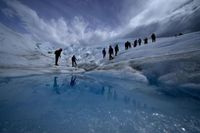For decades, the Perito Moreno Glacier in Argentina’s Southern Patagonian Ice Field stood as a symbol of glacial resilience—a rare giant that seemed immune to the relentless retreat afflicting so many of its icy peers. Tourists flocked by the hundreds of thousands each year, marveling at its towering blue walls and the thunderous calving of ice into Lake Argentino. It was, as Communications Earth & Environment recently described, “one of the most well-known glaciers worldwide.”
But new research published this week has shattered the glacier’s reputation for stability. According to the Associated Press and the study’s authors, Perito Moreno is now experiencing its “most substantial retreat in the past century.” Since 2020, dramatic timelapse photos have captured the glacier losing its grip on the bedrock below, inching backward and shedding more ice with each passing year. The change, while visually stunning, is also deeply troubling—an unmistakable sign that even the planet’s most iconic glaciers are not immune to the effects of a warming world.
“We believe that the retreat that we are seeing now, and why it is so extreme in terms of values that we can observe, is because it hasn’t been climatically stable for a while now, for over a decade,” Moritz Koch, a doctoral student at the Friedrich-Alexander University of Erlangen-Nuremberg and lead author of the study, told the AP. “Now we see this very delayed response to climate change as it is slowly but surely detaching from this physical pinning point in the central part of the glacier.”
The research team, led by Koch, went to extraordinary lengths to document the glacier’s retreat. They conducted extensive fieldwork, flying over Perito Moreno in a helicopter with a radar device suspended beneath to measure the thickness of the ice. Sonar equipment was deployed on Lake Argentino to map the glacier’s underwater profile, while satellites provided a bird’s-eye view of the changes unfolding from above. The result is a detailed, multi-dimensional portrait of a glacier in crisis.
What makes Perito Moreno’s story so remarkable isn’t just the scale of its recent retreat, but the fact that it had long been considered an anomaly among glaciers. As Richard Alley, an ice scientist at Pennsylvania State University who was not involved in the study, explained to the Associated Press, “People who deny climate change frequently point to anomalies like Perito Moreno, which for a long time wasn’t retreating when most other glaciers were.” Its apparent stability was often cited as evidence that not all glaciers were succumbing to global warming—fuel for those skeptical of climate science.
But as the new data show, even glaciers that appear stable can harbor vulnerabilities beneath the surface. Koch’s team found that Perito Moreno’s apparent resilience was, in fact, masking a delayed response to more than a decade of climatic instability. The glacier’s unique position—wedged securely in a valley and anchored to the bedrock—had allowed it to resist retreat for years. But as warming temperatures chipped away at its foundation, it finally began to lose contact with the rock below. The result: a sudden, dramatic increase in ice loss, with researchers predicting that the glacier will retreat several more kilometers in the next few years.
The physics behind this process are, in some ways, intuitive. “Heat melts ice, and global warming means more and faster glacial melting,” Alley told the AP. But as he pointed out, predicting exactly when and how a glacier will break apart is far from simple. It’s a bit like dropping a coffee mug—everyone knows it will shatter, but the precise moment and pattern of the break are much harder to foresee.
Erin Pettit, a glaciologist at Oregon State University who was also not involved in the study, emphasized that glaciers naturally fluctuate even in the absence of climate change. “If the climate were stable, ordinary accumulation of snow and ice would offset the melting and movement,” she explained. But in a warming world, that balance is thrown off, and even the most robust glaciers eventually succumb.
For the people who live near Perito Moreno and the hundreds of thousands of visitors who travel to see it each year, the glacier is more than just a scientific curiosity. Declared a UNESCO World Heritage Site in 1981, it has carved out the dramatic Patagonian landscape and become a vital part of local culture and economy. Glaciers like Perito Moreno are also crucial sources of drinking water for many communities, and when they collapse, they can unleash destructive mudslides that reshape entire valleys.
“We are losing these little bits of ice everywhere,” Pettit told the AP. “Hopefully we’re slowly gaining more respect for the ice that was here, even if it’s not always there.” Her words echo the growing sense of urgency among scientists and policymakers as glaciers around the world retreat at unprecedented rates.
While the changes unfolding in Patagonia are locally spectacular, researchers warn that the implications are global. Melting glaciers contribute to catastrophic sea level rise, threatening to displace millions of people living in coastal and island regions. “The bigger concern is using studies like this one to understand what might happen to the big guys in Antarctica,” Alley said. The fate of Perito Moreno, in other words, may offer a glimpse into the future of much larger ice sheets whose collapse could have far more dire consequences for humanity.
For now, the Perito Moreno Glacier stands as both a warning and a wonder—a reminder of nature’s power and fragility. Its story, meticulously documented by Koch and his colleagues, underscores the importance of respecting and protecting the world’s remaining ice. As the glacier continues its retreat, scientists will be watching closely, hoping that the lessons learned in Patagonia can help avert even greater losses elsewhere.
With its thunderous calving and breathtaking vistas, Perito Moreno will likely remain a magnet for tourists and a source of awe for years to come. But beneath the surface, the glacier’s transformation is a stark testament to the profound changes reshaping our planet—one chunk of ice at a time.




